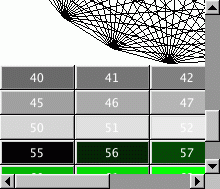
Public Types | |
| enum | { HORIZONTAL, VERTICAL, BOTH, ALWAYS_ON, HORIZONTAL_ALWAYS, VERTICAL_ALWAYS, BOTH_ALWAYS } |
Public Member Functions | |
| void | bbox (Rectangle &) |
| void | enable_drag_scroll (bool enable) |
| virtual int | handle (int) |
| virtual void | layout () |
| ScrollGroup (int x, int y, int w, int h, const char *l=0, bool begin=false) | |
| int | xposition () const |
| int | yposition () const |
| void | scrollTo (int, int) |
Public Attributes | |
| Scrollbar | scrollbar |
| Scrollbar | hscrollbar |
Protected Member Functions | |
| void | draw () |

The default type() will just scroll a whole arrangement of widgets and never resize them. This is useful if you just want to get a big control panel into a smaller window. The bounding box of the widgets are the area it can scroll, this will remove any borders, if you want the borders preserved put some invisible widgets there as placeholders.
This can be used to pan around a large drawing by making a single child widget "canvas". This child widget should be of your own class, with a draw() method that draws everything. The scrolling is done by changing the x() and y() of the widget and drawing it with the fltk clip region set to the newly exposed rectangles. You can speed things up by using not_clipped() or intersect_with_clip() to detect and skip the clipped portions of the drawing.
By default you can scroll in both directions, and the scrollbars disappear if the data will fit in the area of the scroll. type() can change this:
If you use HORIZONTAL or VERTICAL you must initally position and size your child widgets as though the scrollbar is off (ie fill the box() width entirely if type() is VERTICAL). The first time layout() is called it will resize the widgets to fit inside the scrollbars.
It is very useful to put a single PackedGroup child into a VERTICAL ScrollGroup.
Also note that scrollbar_align() (a Style parameter) can put the scrollbars on different sides of the widget.
Currently you cannot use Window or any subclass (including GlWindow) as a child of this. The clipping is not conveyed to the operating system's window and it will draw over the scrollbars and neighboring objects.
|
|
Set the rectangle to the scrolling area (in the ScrollGroup's coordinate system). This removes the border of the box() and the space needed for any visible scrollbars. |
|
||||||||||||
|
Set xposition() and yposition() to these new values, thus scrolling the display. |
|
|
Return the horizontal scrolling position. This is the distance from the left-most widget to the left of the bbox(). |
|
|
Return the vertical scrolling position. This is the distance from the top-most widget edge to the top of the bbox(). |
 ©2006 Bill Spitzak and others.
©2006 Bill Spitzak and others.